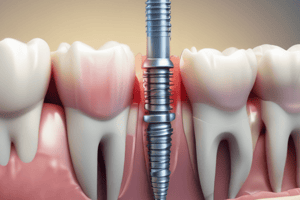Podcast
Questions and Answers
What type of dental material is used for fabrication of crowns, bridges, and dentures?
What type of dental material is used for fabrication of crowns, bridges, and dentures?
- Auxiliary Materials
- Restorative Materials
- Indirect Restorative Materials (correct)
- Direct Restorative Materials
Which property of dental materials is defined as the ability to resist corrosion?
Which property of dental materials is defined as the ability to resist corrosion?
- Solubility
- Toxicity
- Biocompatibility
- Corrosion resistance (correct)
What is the composition of amalgam?
What is the composition of amalgam?
- Mercury, silver, tin, copper, zinc (correct)
- Mercury, silver, copper, zinc
- Glass powder, polyacid
- Resin matrix, filler particles
What is the primary use of composite resin?
What is the primary use of composite resin?
What is the primary use of glass ionomer cement?
What is the primary use of glass ionomer cement?
Which dental material is known for its aesthetic properties?
Which dental material is known for its aesthetic properties?
What is the primary use of dental implants?
What is the primary use of dental implants?
Which property of dental materials is defined as the ability to resist decay?
Which property of dental materials is defined as the ability to resist decay?
Flashcards are hidden until you start studying
Study Notes
Classification of Dental Materials
- Direct Restorative Materials:
- Used for direct filling of cavities
- Examples: amalgam, composite resin, glass ionomer cement
- Indirect Restorative Materials:
- Used for fabrication of crowns, bridges, and dentures
- Examples: metals (gold, silver, titanium), ceramics, polymers
- Auxiliary Materials:
- Used to aid in dental procedures
- Examples: impression materials, gypsum products, dental waxes
Properties of Dental Materials
- Physical Properties:
- Strength (compressive, tensile, shear)
- Hardness
- Density
- Thermal conductivity
- Chemical Properties:
- Solubility
- Corrosion resistance
- Biocompatibility
- Biological Properties:
- Biocompatibility
- Toxicity
- Antimicrobial properties
Restorative Materials
- Amalgam:
- Composition: mercury, silver, tin, copper, zinc
- Properties: high strength, durability, low cost
- Uses: posterior restorations
- Composite Resin:
- Composition: resin matrix, filler particles (silica, quartz)
- Properties: aesthetic, durable, bonding to tooth structure
- Uses: anterior and posterior restorations
- Glass Ionomer Cement:
- Composition: glass powder, polyacid
- Properties: fluoride release, bonding to tooth structure
- Uses: pediatric dentistry, non-load bearing restorations
Additional Dental Materials
- Ceramics:
- Composition: metal oxides (alumina, zirconia)
- Properties: aesthetic, high strength, biocompatibility
- Uses: crowns, bridges, implants
- Dental Implants:
- Composition: titanium, zirconia
- Properties: biocompatibility, osseointegration
- Uses: tooth replacement
- Dental Cements:
- Composition: zinc oxide, eugenol
- Properties: insulating, antibacterial
- Uses: luting, temporary restorations
Classification of Dental Materials
- Direct restorative materials are used for filling cavities and include amalgam, composite resin, and glass ionomer cement.
- Indirect restorative materials are used for fabrication of crowns, bridges, and dentures and include metals, ceramics, and polymers.
- Auxiliary materials are used to aid in dental procedures and include impression materials, gypsum products, and dental waxes.
Properties of Dental Materials
Physical Properties
- Strength, hardness, density, and thermal conductivity are important physical properties of dental materials.
Chemical Properties
- Solubility, corrosion resistance, and biocompatibility are key chemical properties of dental materials.
Biological Properties
- Biocompatibility, toxicity, and antimicrobial properties are important biological properties of dental materials.
Restorative Materials
Amalgam
- Composed of mercury, silver, tin, copper, and zinc, amalgam has high strength, durability, and low cost, making it suitable for posterior restorations.
Composite Resin
- Composed of resin matrix and filler particles, composite resin is aesthetic, durable, and bonds to tooth structure, making it suitable for anterior and posterior restorations.
Glass Ionomer Cement
- Composed of glass powder and polyacid, glass ionomer cement releases fluoride, bonds to tooth structure, and is suitable for pediatric dentistry and non-load bearing restorations.
Additional Dental Materials
Ceramics
- Composed of metal oxides, ceramics are aesthetic, have high strength, and are biocompatible, making them suitable for crowns, bridges, and implants.
Dental Implants
- Composed of titanium and zirconia, dental implants are biocompatible, osseointegrate, and are suitable for tooth replacement.
Dental Cements
- Composed of zinc oxide and eugenol, dental cements are insulating, antibacterial, and are suitable for luting and temporary restorations.
Studying That Suits You
Use AI to generate personalized quizzes and flashcards to suit your learning preferences.




